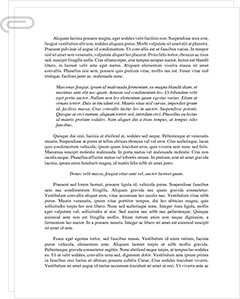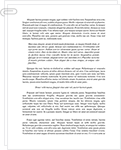 Study Document
Study Document
How Bulimia Nervosa Can Impact Society and Young Women Article Review
Pages:9 (2692 words)
Sources:8
Document Type:Article Review
Document:#18859580
AbstractThe below literature review will discuss the theories of body image perception as it relates to bulimia nervosa. The document will discuss the implication of social media on the perception of the idea of beauty in the minds of young women. Social media, particularly, the idea of perfection and how unrealistic it is to obtain will be observed using peer-reviewed articles. Likewise, the role of societal pressures related ideal weight, size and shape will also be reviewed. Finally, the overall science behind bulimia nervosa will be discussed with a particularly emphasis on the psychological implication of peer approval.For one all of these elements are heavy correlated the bulimia nervosa. Young women are particularly susceptible to this disorder as their brains are still developing. Here, young women attempt to make sense of the various stimuli around them, namely advertisements, social norms, social media, and peers. As research will attest, female peers have by far the highest influence on young women than any other medium. The need to fit in and be accepted by peers creates a clear juxtaposition between what the young female would like to do versus what society and her peers demand her to do. This phenomenon occurs quite frequently with teenagers who leverage various tactics to demean others. Element such as in-person bullying, cyber-bullying, and even violence emanates from a need to fit in and be accepted. From the female perspective a large portion is verbal and is heavily correlated to appearance. Those that dont conform to the standard of beauty are often ridiculed, shunned and ostracized. As a result, many turns to self-destructive behaviors such as bulimia nervosa, which inevitably causing still further harm to the individual. This document will look to identify the psychological catalysts of this behavior while offering peer-reviewed solutions to help mitigate its occurrence (Grilo, 2019)IntroductionTo begin bulimia nervosa is a potentially life-threatening eating disorder that impacts nearly 5% of American women during their lifetime. This number is heavily skewed as many victims of this disorder never report it to the appropriate authorities or healthcare professionals. Typically, the eating is disorder is characterized an individual consuming a large number of calories over a given period, and then attempting to rid themselves of the calories in an unhealthy manner. The objective is often to maintain an often-unobtainable beauty standard or to simply prevent weight gain. The most common method of eliminating this caloric intake is through the use of vomiting, laxatives, or enemas. Other, less invasive techniques include unhealthy amounts of dieting and fasting. Still others use excessive amounts of exercise as a means of circumventing weight gain.The most common symptom of bulimia nervosa is a large preoccupation with person body shape and weight. This preoccupation is typically influenced by societal norms, trends, and peers. Likewise, the individual experiencing bulimia nervosa often lives in fear of gain weight and looks to maintain a certain image to uphold a public persona. This symptom has been particularly exacerbated by the growing influence of social media on the lives of young women. Here, many young women, in an effort to garner Likes, Subscribers, and Followers looks to maintain an ideal and often unrealistic body image. In order to do, many resorts to many of the tactics presented in the paragraph above including vomiting, laxatives, diuretics, and supplements. By engaging in these activities excessively, many women risk health complications that can be long lasting and severely adverse to their overall lifespan. Finally, the severity of the disorder pertains to the number of times an individual looks to purge or use the techniques mentioned above. If an individual engages…
…to garner the most attention, likes, follower, and subscribers. This only further validates the position of young teenage women looking to find their place in the world. Here, they believe that possessing these ideal forms of beauty are necessary to be successful. As a result, they engage in self-destructive behavior that ultimately undermines their creative ability, talents and abilities (Grilo, 2019).ConclusionTo conclude, the influence of society as it relates to beauty and its meaning are detrimental to young and impressionable females. The research justifies this assumption as studies show that women are often diagnosed with bulimia nervosa because of a need to be accepted by society. Here, society perpetuates a unobtainable stereotype that many young women feel pressured to meet. This often culminates into bulimia nervosa where women engage in behaviors that harm their person health and well-being. This creates an interesting dichotomy as women must leverage their own self-esteem and self-care to help combat the influences of society. However, as the research has shown, women experience bulimia nervosa often do not have the degree of self-compassion necessary to circumvent the pressures associated with bulimia nervosa. Social media also plays a large role as many people on the platform simply lie about their lives. They often preset a false narrative in order to garner subscribers, likes and followers. Here, their lives are not nearly as positive as they make it seem, but they do so because young men and women are very impressionable. As a result, they leverage this false narrative to the detriment of the young society and younger generations. To overcome this concept, the research suggests that women must find pleasure in their own self-worth and abilities. Here, they must mitigate the impact others have on their lives and instead focus on the skills, abilities and talents they possess…
Related Documents
 Study Document
Study Document
Women's Objectification in Society
Women Objectification Women's Objectification in Society Women's Objectification in Society It is crucial to notice the language we use when we talk about bodies. We speak as if there was one collective perfect body, a singular entity that we're all after. The trouble is, I think we are after that one body. We grew up with the impression that underneath all this normal flesh, buried deep in the excessive recesses of our healthy
 Study Document
Study Document
Symptoms of Anorexia and Bulimia
Anorexia and Bulimia Factors Influencing the Incidence of Anorexia and Bulimia The two primary eating disorders in Western countries are anorexia nervosa and bulimia nervosa. Women constitute the primary sufferers of these diseases, with 0.5% to 3.7% and 1% to 3.7% suffering from anorexia and bulimia, respectively (Scott, Hardman, and Berrett, 2007, p. 14). Men also suffer from these eating disorders, but at about one-tenth the rate. Anorexia is defined by a subnormal
 Study Document
Study Document
Sexuality and Self-Image: Women in
Surprisingly, BDD, which is often a precursor to or comorbid symptom of eating disorders such as anorexia and bulimia nervosa, is nearly as common among young men as women. This indicates that the onslaught and idolization of media images of "gorgeous" men in America is also having a negative effect on boys' sexual self-images. (da Costa, Nelson, Rudes, & Guterman, 2007) Narrowing the focus down to American women and their
 Study Document
Study Document
Eating Disorders in Women from the Christian Point of View
Eating disorders are the number one cause of mortality among mental disorders. A significant portion of women in America suffer from eating disorders. This paper describes these disorders and identifies common, practical and theoretical approaches to eating disorders that are used by counselors, therapists and care givers to help women overcome their struggles. It discusses some of the causes of these disorders. Finally, it identifies the how the Christian perspective
 Study Document
Study Document
Sex Appeal to Market Our Athletes
They are there to play and not to show off their bodies. Female athletes with larger body size will find discomforts in the tightly fitted uniforms. This then presents problem to safety. The female athletes who will not be at ease to the required uniform could not focus on the game she is playing. She will, from time to time, try to rearrange, pull or push some parts o the
 Study Document
Study Document
Eating Disorders and Perception of Beauty
Eating Disorders How the Perception of Beauty Influences Eating Disorders With everything changing in this society, the aspect of beauty especially when it comes to women has kept changing, sometimes desperately to the extent of individuals adopting extreme behaviors in the pursuit of the ideal 'beauty'. Instances where different kinds of media communicate the significance of physical beauty in the contemporary world and the means of achieving such traits are widespread. The




